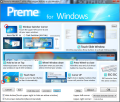The progress Microsoft has made with Windows 7 in terms of usability and functionality is an undeniable fact. Only at the taskbar level the improvements are notable: jumplists, thumbnail preview, icon-like windows, pining option or rearranging of the tasks. Moving over to window management, Windows 7 introduces AeroShake to clear the desktop and AeroSnap to resize and compare windows on the desktop.
Although there are users unconvinced by these features, many have changed their standard of how an operating system should behave and the options it should include. And for the latter category all the aforementioned features represent only the beginning because there is still plenty of room to develop functionality and usability of the desktop to new levels.
Preme for Windows 7 extends the default desktop functionality of the operating system to new limits, and by that I mean that it delivers a set of options that can help you better manage the windows on your desktop. It is a freebie released recently and compiled with AutoHotKey. There is no proper interface available, only a screen displaying the options, which also lets you enable the various actions available. This window presents all the options and, more important, the effect each enabled option has on the system.
The program provides a total of seven new shortcuts for different actions in Windows 7. You have the possibility to change the way Flip 3D or Task Switcher are accessed and instead of using the keyboard you can simply move your mouse to the upper left or right corner of the desktop. Depending on which of these corners you assign this action, the behavior on the other when touched with the mouse will be to hide the active window.
Hiding the active window this way comes in handy if the active window is the only obstacle for viewing the screen behind it. With Preme the action is almost instantaneous, as opposed to previewing from Windows thumbnails, which take a tad longer.
A very cool function is called “Touch Slide Window”, which causes application screens to slide to the side (left or right part of the desktop screen) and hide when clicked right under the minimize, restore and close buttons. The windows will just skip to the side and become visible only when touching the edge of the desktop with the mouse. The beautiful part is that even docked, the windows are fully functional, this is to say that you can work in these screens and once you take the mouse outside its borders it’ll automatically skid to the side.
The title bar has been awarded triple functionality by the developer of Preme, depending on mouse action. Keeping the cursor on this part of the window and scrolling down will automatically minimize it to the taskbar. If you press the mouse wheel the effect will be to close the active window (also, double tap ESC key to the same effect). The third behavior occurs when you click the titlebar and hold your click for a second: the effect is that the window will be on top of all other screens. When trying this we noticed that the window blinks both when enabling the behavior as well as when disabling it.
These are the most important and interesting actions available in Preme, but not all of them. The application offers a fast way to access Start menu by simply getting your mouse to the lower left corner of the desktop. There isn’t any difference from the regular method of access except for the fact that you no longer have to click the Start button.
By default, right clicking on the taskbar buttons should automatically place the cursor on the Close option. However, during our tests this option worked sporadically. It often happened to see it in action at one moment and the next to fail completely, despite the same application window being involved.
Some sort of configuration is present in the lower part of the screen, under the “More” drop-down menu. It lets you enable full-screen detection, and configure the effect of taking the mouse to the upper left/right corner.
How each action works and how you can be activated is pretty much covered for all of the options present in the application. What you may have trouble understanding from the first glance on Preme’s configuration window is the “Touch Slide Window” function. The graphical representation may be sufficient for some, but just to make sure you got it right I suggest you click on “How?” button for a live tutorial. For the few seconds the tutorial runs you will not have full control over your computer, which may not be appreciated by the users.
Preme for Windows 7 is not stuffed to the brim with options, but it offers some interesting choices for handling the windows on the desktop. Either dock them to the side, place the one that interests you the most on top of all the others or minimize it with a scroll on the title bar, these are functions a user can easily grow dependent on.
Though in early development stage and sporting simple options, Preme works like a charm and adds functionality to your Windows 7 desktop. Follow me on Twitter @Ionut_Ilascu
The Good
The Bad
The Truth
 14 DAY TRIAL //
14 DAY TRIAL // 

